To spread the original, universal and eternal truth, path or law of yoga, which remains forever the same in essence, yet always adapts to the time and place. |
Meditation on paintings of deities is an essential
part of Tantra Yoga.
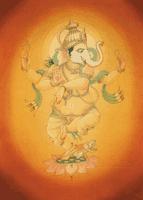 In
Tantra
Yoga, the meditation on paintings of deities and yantras
of deities is an essential part of Tantric
worship. It enables one to get in contact with the energy patterns
associated with the deity. The deity image or the deity yantra is
the form or body of the deity, wheras the mantra of the deity is
the mind, spirit, consciousness or name.
In
Tantra
Yoga, the meditation on paintings of deities and yantras
of deities is an essential part of Tantric
worship. It enables one to get in contact with the energy patterns
associated with the deity. The deity image or the deity yantra is
the form or body of the deity, wheras the mantra of the deity is
the mind, spirit, consciousness or name.
Using the faculties of hearing and sight together is tantra. One subtly receives information from the forms, colors and sounds. Tantra enables a type of learning that goes beyond rational understanding to really feeling and knowing truth. Meditation on paintings of deities and on yantras works through the visual hemisphere of our brain.
On a very basic level, the meditation on paintings of deities is simply easier than the meditation on abstract concepts. By concentrating on Ganesha and the spiritual attitude that he symbolises, one strengthens that attitude within one self. Daily concentration on the courage and selffless service of Hanuman will make it that much easier to follow his example in time of need, with both the mental image of the deity and the related mantra acting as carriers of that attitude. The same goes for all gods and goddesses, such as Durga being a great help in overcoming our internal demons.
One might say that in this way meditation on the painting of a deity helps one to awaken that deity within oneself. When a yantra or other painted representation of a deity is adopted for worship and the energy is invoked in it, it becomes a symbolic representative of the deity - and actually it is the deity himself when the sadhak abandons his analytical, critical nature - and the energy circulates in the higher centers. Every such painting becomes the dwelling place of the deity by whose name it is known.
That process obviously starts with the meditative creation of the painting by the artist himself. The act of painting is an act of worship, especially if also accompagnied by meditation on the particular nature and energy of the deity and by the recitation of mantras. Pranapratishtha, the invoking of prana (vital life force) of the deity is essential for a yantra or an idol, and this is done with the help of mantras.
Through meditative painting and through further worship, paintings of deities may thus gather particular energies and become objects of power. This is similar to the relics of saints being powerful or temples and other places of worship that have become places of power. The particular nature and concentration of energy depends on the nature and concentration of the worship performed and on the deity that is respresented. Such energy "stored" in a painting might for example facilitate meditation.
Saguna Dhyana
Dhyana
(uninterrupted meditation)
is of two types : saguna, with form (sa - with, guna - attribute)
and nirguna (nit - without, guna - attribute) . 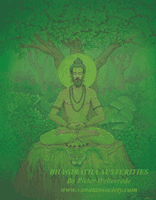 In
Tantra Yoga, meditation on the chakras
and their deities is with form until Kundalini
pierces the sixth chakra. Then it becomes meditation on the formless
supreme truth (nirguna dhyana). This is the final stage of dhyana,
the concentration on the supreme truth having no shape, form or
name.
In
Tantra Yoga, meditation on the chakras
and their deities is with form until Kundalini
pierces the sixth chakra. Then it becomes meditation on the formless
supreme truth (nirguna dhyana). This is the final stage of dhyana,
the concentration on the supreme truth having no shape, form or
name.
Although meditating on the formless, nameless, supreme truth is the summum bonum of dhyana, it can only be achieved by prolonged practice of concentration on the deities with form. It is the journey of the I-consciousness from precept to concept. It is said that a precept without a concept is empty and a concept without a precept is blind.
The process of transcending from form to formless is like learning the initially abstract characters of the alphabet through the use of examples. Then after one has learned the alphabet, the apple for "A", ball for "B" and cat for "C" disappear. One can then make words and communicate by combining the letters of the alphabet into words, sentences and paragraphs. Just as symbols of the alphabet are helpful in learning a language, the deities of the chakras are helpful in spiritualisation of the cognitive, conative and affective aspects of consciousness. Then, just as the symbols and also the characters themselves disappear, the divities with form also vanish when the formless divinity is reached.
Kundalini Yoga
In Kundalini Yoga, the meditation on and the visualisation of the chakras is done in gradual progression, beginning with the first chakra and moving step by step towards the seventh. The center of concentration should be the chakras and not the gross organs of the body. Yoga schools that provide no images of chakras can only suggest that the sadhaka should meditate on the heart or between the eyebrows. However, this keeps the focus on the body, whereas the goal in Kundalini Yoga is to go beyond body consciousness. In Kundalini meditation, one gets absorbed in the abstract yantras, mantras, deities of the chakras, which spiritualises the consciousness. Thus tantric visualisation aided by coloring the images of the chakras is a much more effacious practice.
To help prepare for meditation on the chakras, the sadhaka should first color the images of the chakras to establish them in the mind's eye. Then once one has colored the images, they are retained in the mind and internal visualisation becomes easy.
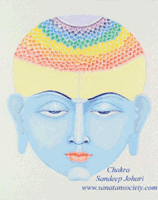 Thus
working with the first chakras also includes working with Brahma
and Ganesha. The second chakra is related to Vishnu
and the Rakini Shakti.
Third chakra meditation involves Rudra (a form of Shiva)
and Lakini Devi, a compassionate form of Kali.
Fourth is related to Ishana Rudra Shiva, a symbol of detached happiness.
The doorkeeper of this chakra is Kakini Shakti and it is also here
that the Kundalini Shakti appears for the first time. In the fifth
chakra, the deity is Panchavakta Shiva, a combination of all Shiva
energies. The doorkeeper is Shakini, the embodiment of purity. In
the sixth chakra, Shiva and Shakti merge into Ardhanarishvara, half
male, half female. The doorkeeper is the goddess Hakini, an aspect
of the Kundalini Shakti. In the seventh chakra Kameshvari and Kameshvara
should be meditated upon, Shiva and Shakti, the Lord and goddess
of desires, seated upon a lotus in eternal embrace.
Thus
working with the first chakras also includes working with Brahma
and Ganesha. The second chakra is related to Vishnu
and the Rakini Shakti.
Third chakra meditation involves Rudra (a form of Shiva)
and Lakini Devi, a compassionate form of Kali.
Fourth is related to Ishana Rudra Shiva, a symbol of detached happiness.
The doorkeeper of this chakra is Kakini Shakti and it is also here
that the Kundalini Shakti appears for the first time. In the fifth
chakra, the deity is Panchavakta Shiva, a combination of all Shiva
energies. The doorkeeper is Shakini, the embodiment of purity. In
the sixth chakra, Shiva and Shakti merge into Ardhanarishvara, half
male, half female. The doorkeeper is the goddess Hakini, an aspect
of the Kundalini Shakti. In the seventh chakra Kameshvari and Kameshvara
should be meditated upon, Shiva and Shakti, the Lord and goddess
of desires, seated upon a lotus in eternal embrace.
As an example of excellence, meditating on Kameshvari and Kameshvara stops the natural downward flow of nectar (amrit). Thus the upward flow of energy is enhanced, enabling the yogi to stay in the Brahma Randhra or Shunya Mandala (void center), the hollow space between the twin hemispheres. He or she who thus stops the downward flow of nectar becomes immortal in the phsyical body. He or she thus remains forever young, enjoying eternal bliss through the union of Shiva and Shakti, the ultimate goal of Kundalini Yoga.
Using paintings in tantric worship
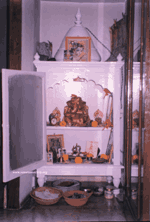 Paintings
and sculptures of deities are an essential part of the Hindu worship
known as Puja (or Pooja). In temples or home shrines, one finds
images of many gods and goddesses that are worshipped on a daily
basis. Many different kinds of tantric worship and puja exist, in
which meditation on the yantra, painting or sculpture of the deity
is just a part.
Paintings
and sculptures of deities are an essential part of the Hindu worship
known as Puja (or Pooja). In temples or home shrines, one finds
images of many gods and goddesses that are worshipped on a daily
basis. Many different kinds of tantric worship and puja exist, in
which meditation on the yantra, painting or sculpture of the deity
is just a part.
Many kinds of worship are prescribed according to the nature of the aspirant and the objectives of the worship. The sadhak is free to choose a deity or yantra, whichever triggers him or her emotionally. He or she has a multitude of gods and goddesses to choose from. Each represents an aspect of the divine or of the spiritual path.
Worship of Lord Ganesha is one of the unique features of tantric sadhana. The external image of Ganesha is charming and attractive, although not acceptable to the rational mind. Worshiping Ganesha quiets the left hemisphere and enables worship to be performed without obstacles. The greatest of all obstacles is our own doubt, which weakens faith and blocks worship as the path of spiritual evolution. Removing that doubt is the purpose of worshipping Ganesha at the start of any tantric worship.
The worship should begin with purification. Visualisation should be practiced only when one's breathing does not interrupt ones' concentration, so breath controll excercises (pranayama) should be done before visualisation.
For many, visualisation is not easy. Painting deities and yantras and then using those paintings in visualisation is the easiest way to develop the practice of more abstract visualisation, which in time will lead to deep meditation.
Effects of paintings without meditation
Even if paintings of deities are not directly used in meditation, they can be usefull far beyond the purely decorative effect. Having them around subtle affects one's mind and keeps one in a more spiritual mood. Especially if one knows the stories that explain their symbolised energies, these paintings become real friends. They can lift ones' mood in the blink of an eye. Subtle effects can be very powerful triggers to changing how one feels. As symbols of perfection, deities usually make a better case than most mortals.
Paintings of deities should preferable be hanged into relatively clean and pure places. Giving these paintings proper respect, keeping them clean and clear, is act of worship already. Small offerings of flowers, insense, etc... contribute to creating a spiritual athmosphere around the painting and deepening our relationship with the divine within and without. Inviting paintings of deities in ones home, means subtly inviting their energies as well.
Text extracted and added to by Peter Marchand, on the basis of the books "Tools for Tantra" and "Chakras" by Harish Johari.
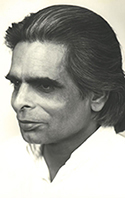 Sanatan Society is an international networking association of students of the late Harish Johari, joining efforts to promote his teachings of yoga philosophy, tantra, worship, art and love. Sanatan Society stands
for the original, universal and eternal truth, path or law of yoga.
Though it is Hindu in origin, Sanatan Society is not limited to any religion,
race, time or country, nor in fact to any particular organisation. More about Sanatan Society...
Sanatan Society is an international networking association of students of the late Harish Johari, joining efforts to promote his teachings of yoga philosophy, tantra, worship, art and love. Sanatan Society stands
for the original, universal and eternal truth, path or law of yoga.
Though it is Hindu in origin, Sanatan Society is not limited to any religion,
race, time or country, nor in fact to any particular organisation. More about Sanatan Society...